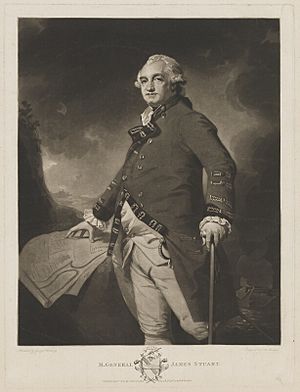James Stuart (British Army officer, born 1741) facts for kids
Quick facts for kids
James Stuart
|
|
|---|---|
 |
|
| 2nd Military Governor of British Ceylon | |
| In office 1 March 1796 – 1 January 1797 |
|
| Monarch | George III |
| Preceded by | Patrick Alexander Agnew |
| Succeeded by | Welbore Ellis Doyle |
| 1st General Officer Commanding, Ceylon | |
| In office 1796–1796 |
|
| Preceded by | New Command |
| Succeeded by | Welbore Ellis Doyle |
| Personal details | |
| Born | 2 March 1741 Blairhall Perthshire, Scotland |
| Died | 29 April 1815 Charles Street, Berkeley Square, London |
| Resting place | St. James's Chapel, London, England |
| Signature |  |
| Military service | |
| Allegiance | United Kingdom |
| Branch/service | British Army |
| Rank | General |
| Commands | General Officer Commanding, Ceylon Madras Army |
| Battles/wars | |
General James Stuart (1741–1815) was an important officer in the British Army. He served in North America during the American Revolutionary War. He also took part in many battles in British India. He was the first leader of the army in British Ceylon (now Sri Lanka). He was also the second Military Governor there. He held this role from March 1796 to January 1797.
Contents
Early Life and Education
James Stuart was born on March 2, 1741. He was the third son of John Stuart from a place called Blairhall in Scotland. His mother was Anne, whose father was Francis Stuart, 7th Earl of Moray.
James went to school in Scottish towns like Culross and Dunfermline. He then studied law at the University of Edinburgh. After his studies, he decided to join the British Army. He served in the American Revolutionary War, which was a big conflict at the time.
Military Career in India
Early Campaigns
In 1782, James Stuart was promoted to a major. He arrived in India and quickly became a lieutenant-colonel. He joined a campaign led by Sir Eyre Coote. This was against a ruler named Hyder during the Second Anglo-Mysore War.
Stuart was part of the siege of Cuddalore. This was a long fight to take control of a fort. He led an attack on July 13, 1782.
Wars Against Tipu Sultan
James Stuart also fought in the Third Anglo-Mysore War in 1790. He served under General Sir William Medows against Tipu Sultan. Tipu Sultan was a powerful ruler in India. Stuart helped attack the forts of Dindigul and Palghaut.
Later, he served under Lord Cornwallis in 1791–1792. He led the siege of Seringapatam. This was a major battle to capture Tipu Sultan's capital city. Stuart commanded the central group of soldiers in the attack on February 6, 1792. He was promoted to colonel in August and returned to Madras in 1794.
Taking Command in Ceylon
In 1795, James Stuart was promoted to major-general. He was given command of a mission to take over Dutch areas in Ceylon. After the whole island was secured in 1796, Stuart became the main commander of the forces in Madras that same year.
In 1797, he became the colonel of the 82nd Regiment of Foot. The next year, he moved to the 72nd Regiment of Foot. He stayed in this position until he passed away.
Final War Against Tipu Sultan
In 1799, Stuart led the Bombay Army in the Fourth Anglo-Mysore War. This was the last war against Tipu Sultan. Stuart's army took control of Coorg. They also pushed back Tipu's forces at Seedaseer on March 6.
On March 15, he joined forces with Major General George Harris. Together, they fought in the 1799 Battle of Seringapatam. Stuart was in charge of the operations on the northern side of the city. After the city was captured, both Houses of Parliament thanked him for his efforts.
Later Life and Death
In 1801, James Stuart became the commander-in-chief of the Madras Army. He was promoted to lieutenant-general in 1802. He took part in the Second Anglo-Maratha War in 1803. However, he returned to England in 1805 because his health was not good.
On January 1, 1812, he was promoted to the highest rank: full general. James Stuart passed away on April 29, 1815, in London. He was buried in a vault at St. James's Chapel in London. He did not have any children.

